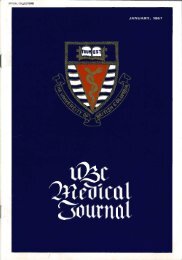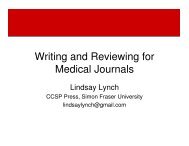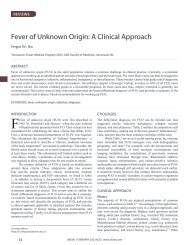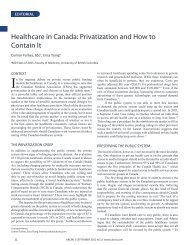Download full PDF - UBC Medical Journal
Download full PDF - UBC Medical Journal
Download full PDF - UBC Medical Journal
You also want an ePaper? Increase the reach of your titles
YUMPU automatically turns print PDFs into web optimized ePapers that Google loves.
FEATURE<br />
2. British Columbia <strong>Medical</strong> Association. Doctors today and tomorrow: Planning<br />
British Columbia’s Physician Workforce [Internet]. 2011 [cited 2013 Jan 14].<br />
Available from: https://www.bcma.org/files/PhysicianWorkforce_paper_WEB.<br />
pdf<br />
3. Association of Professors of Human and <strong>Medical</strong> Genetics. <strong>Medical</strong> school core<br />
curriculum in genetics 2010 [Internet]. 2010 [cited 2013 Jan 14]. Available from:<br />
http://www.aphmg.org/pdf/Med%20Competencies.pdf<br />
4. Gonzaga-Jauregui C, Lupski JR, Gibbs RA. Human genome sequencing in health<br />
and disease. Annu Rev Med. 2012;63:35-61.<br />
5. Sandmann T, Boutros M. Screens, maps & networks: from genome sequences to<br />
personalized medicine. Curr Opin Genet Dev. 2012;22(1):36-44.<br />
6. Association of American <strong>Medical</strong> Colleges. Report VI. Contemporary issues<br />
in medicine: Genetics education [Internet]. Washington (DC): Association of<br />
American <strong>Medical</strong> Colleges; 2004 [cited 2013 Jan 14]. Available from: https://<br />
www.aamc.org/initiatives/msop/<br />
7. AAMC-HHMI Committee. Scientific foundations for future physicians [Internet].<br />
2009 [cited 2013 Jan 14]. Available from: http://www.hhmi.org/grants/pdf/08-209_<br />
AAMC-HHMI_report.pdf<br />
8. University of British Columbia Faculty of Medicine. Dean’s task force<br />
on MD undergraduate curriculum renewal final report [Internet]. 2010<br />
[cited 2013 Jan 14]. Available from: http://cr.med.ubc.ca/files/2011/01/<br />
dtfcrfinalrprt201016902.pdf<br />
9. University of British Columbia Faculty of Medicine. Model MD<br />
undergraduate program curriculum schedule. 2012 [cited 2013 Jan 14].<br />
Available from: http://cr.med.ubc.ca/files/2012/09/Curriculum-Design-<br />
Final-Report-2012.08.21KW.pdf<br />
10. Genome British Columbia. Towards a genomics & health strategy [Internet].<br />
2009 [cited 2013 Jan 14]. Available from: www.genomebc.ca/index.php/<br />
download_file/-/view/16/<br />
Integrating Genomics into Clinical Practice<br />
Linlea Armstrong a , BSc, MD<br />
a<br />
Professor of <strong>Medical</strong> Genetics, Department of <strong>Medical</strong> Genetics, Child and Family Research Institute, University of British Columbia<br />
INTRODUCTION<br />
There are two main clinical scenarios in which genomic<br />
analyses will be pursued. The first is to support the making<br />
of a diagnosis. This is usually, but not always, done in the<br />
context of presenting symptoms or signs. Second, genomics can<br />
be applied to obtain probabilistic assessments. The concept is to<br />
apply genomic information to guide anticipatory health care and/<br />
or optimize the use of “pharma” products. The interpretations of<br />
some of these assessments are complex, and there can be ethical<br />
considerations regarding their integration into a public health<br />
system.<br />
MAKING THE DIAGNOSIS<br />
Copy number variants<br />
Chromosomes are vulnerable to rearrangements involving<br />
deletions and duplications. The resulting variations in the copy<br />
number of the genes are a common cause of developmental/<br />
intellectual differences, often with accompanying minor or major<br />
malformations. The traditional karyotype has limited resolution.<br />
The introduction several years ago of array comparative<br />
genomic hybridization (aCGH) technologies, for identification<br />
of submicroscopic chromosomal deletions and duplications,<br />
increased our ability to offer a specific diagnosis to individuals<br />
with developmental differences by about 20%. 1<br />
Mendelian diseases<br />
Until recently, we had limited abilities to confirm diagnoses of<br />
many conditions that were suspected to be genetic. This was both<br />
Correspondence<br />
Linlea Armstrong, llarmstrong@cw.bc.ca<br />
because the majority of the genes for the Mendelian conditions<br />
had not been identified, and because when there were implicated<br />
genes, testing was too labour intensive. Genomics researchers<br />
have addressed the first problem with genomic sequencing. One<br />
approach is to identify a few patients with a similar diagnosis and<br />
figure out what gene to implicate by determining what gene is<br />
commonly mutated among the patients. Newly identified genes<br />
involved in Mendelian conditions are now reported weekly; the<br />
information is quickly turned into clinical tests for patients in<br />
whom the condition is suspected. A second approach that has<br />
become clinically available within the last year or so is relevant<br />
when a patient appears to have a genetic presentation that is<br />
unrecognizable. The service labs can now do a genomic sequencing<br />
and look at the profile of that person’s variants. The interpretation<br />
uses various approaches to identify a likely responsible mutation.<br />
To address the second problem of the high costs of traditional<br />
single–gene testing, labs have integrated genomic approaches so<br />
as to be able to offer testing for many genes at once, dropping the<br />
cost of each. Panels holding the dozens of genes now known to<br />
be responsible for presentations such as unexplained deafness or<br />
cardiomyopathy allow for efficient, economical diagnostic work<br />
up.<br />
Reproduction<br />
Genomics is significantly changing what is available in the<br />
reproductive realm. Genomics offers alternatives to the traditional<br />
amniocentesis with karyotype analysis for assessment of a fetus’<br />
chromosomes. The higher resolution aCGH analysis discussed<br />
above can be applied to an amniocentesis sample for higher<br />
diagnostic yield. Non-invasive prenatal diagnosis, which uses<br />
a maternal blood sample to assess for fetal aneuploidy, offers<br />
information without the amniocentesis. Further, prospective<br />
8<br />
<strong>UBC</strong>MJ | FEBRUARY 2013 4(2) | www.ubcmj.com










